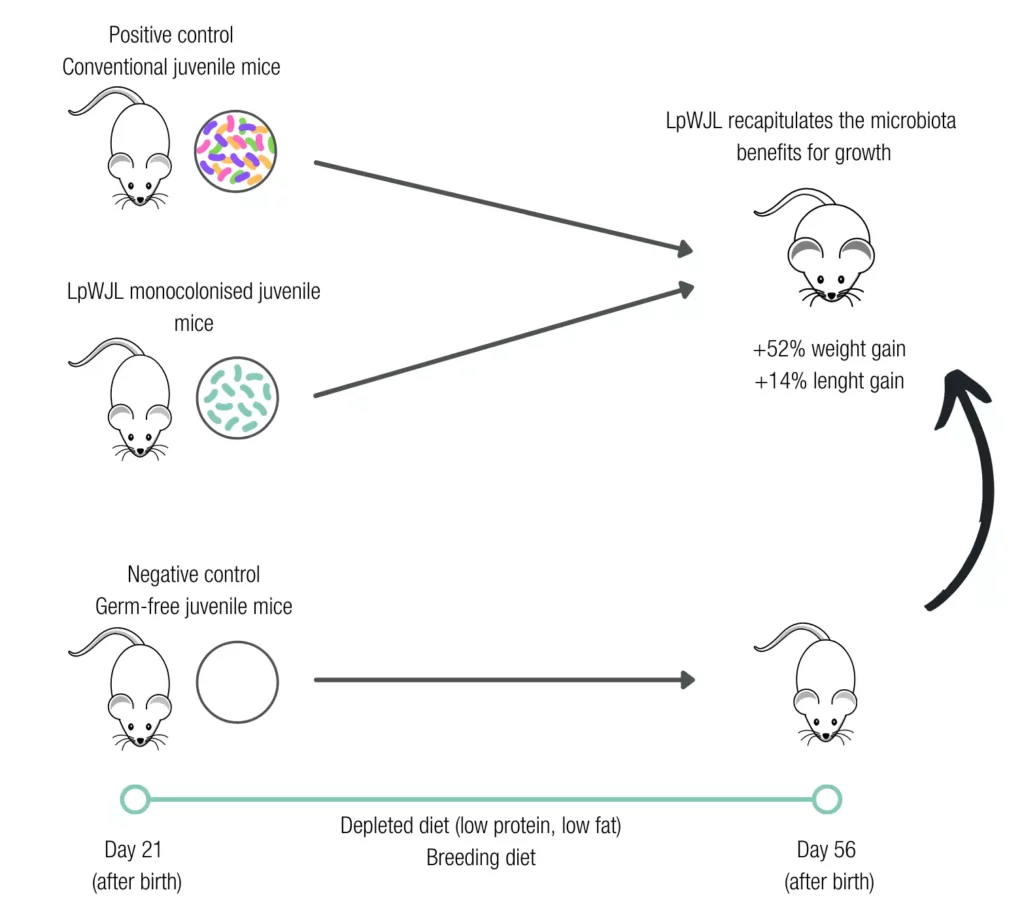Growth and Nutrition
Optimization
with L. plantarum WJL
Mechanism of Action LpWJL Promotes Peptidase Expression and Amino Acids Absorption
1. L. plantarum WJL,
nutrition optimization and growth stimulation
François Leulier and his team at the Institute of Functional Genomics in Lyon (IGFL) identified the positive correlation between Lactiplantibacillus plantarum WJL (LpWJL) and nutrition optimization. Convinced by the importance of the link between microbiome, nutrition, and growth, they studied the effect of this strain and its and its specific mechanism of action on animal absorption of amino acids and growth.
LpWJL expresses specific cell wall components, which in contact with enterocytes, activate the metabolic pathways of growth through an increased absorption of amino acids.
UMFV, 2014
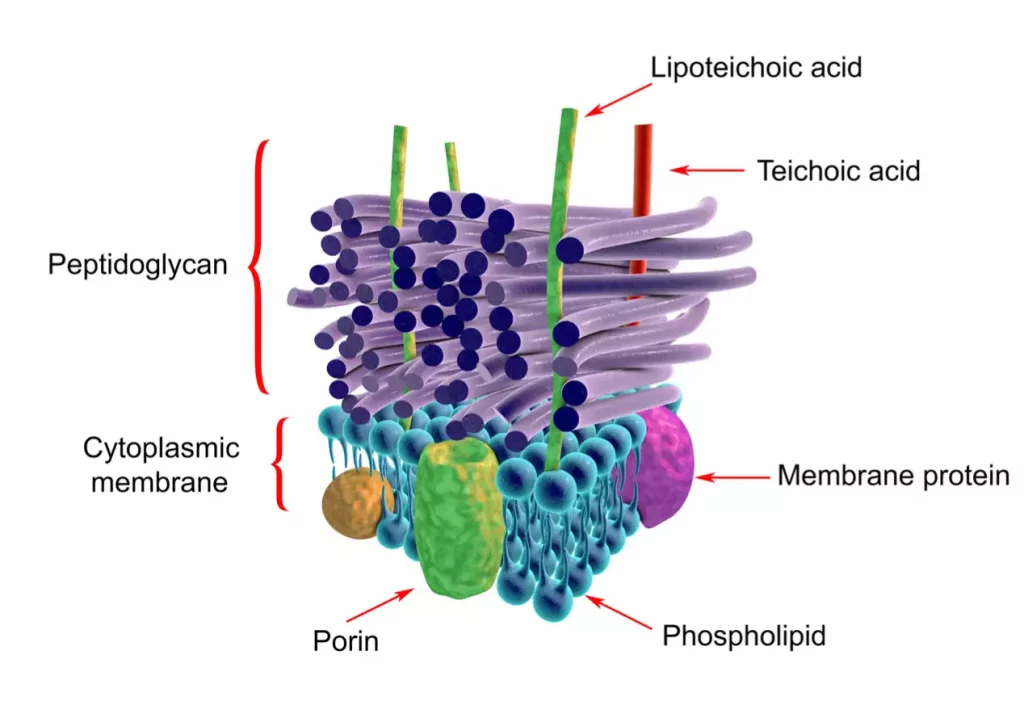
2. Mechanism of action: LpWJL stimulates the somatotropic axis through increased amino acids absorption
The research conducted by the IGFL has shed light on the action of LpWJL on the host, via a stimulation of the somatotropic axis, through 4 different steps:
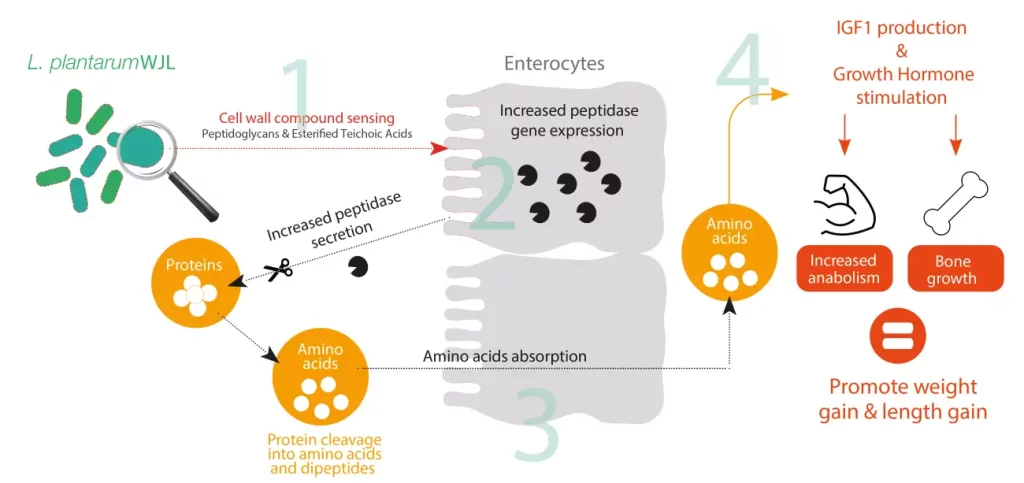
1. Peptidoglycans and D-alanylated teichoic acids from LpWJL are first recognized by receptors on enterocytes.
2. A pathway controlling the expression of peptidase genes is then activated and peptidase production is stimulated. Peptidases are secreted into the gut leading to an increase in the bioavailability of amino acids resulting from the cleavage of dietary proteins.
3. The increased presence of amino acids stimulates the expression of amino acid transporter genes, which are then better absorbed and transported to the various tissues.
4. Nutritional status regulates the somatotropic axis and in particular the concentration of certain hormones. Increased amino acid absorption stimulates sensitivity to the growth hormone GH and raises the concentration of IGF-1, one of the key hormones participating to growth.
Pre-clinical evidence The efficacy of LpWJL in Growth and Nutrition
1. Pre-clinical study: in Drosophila models
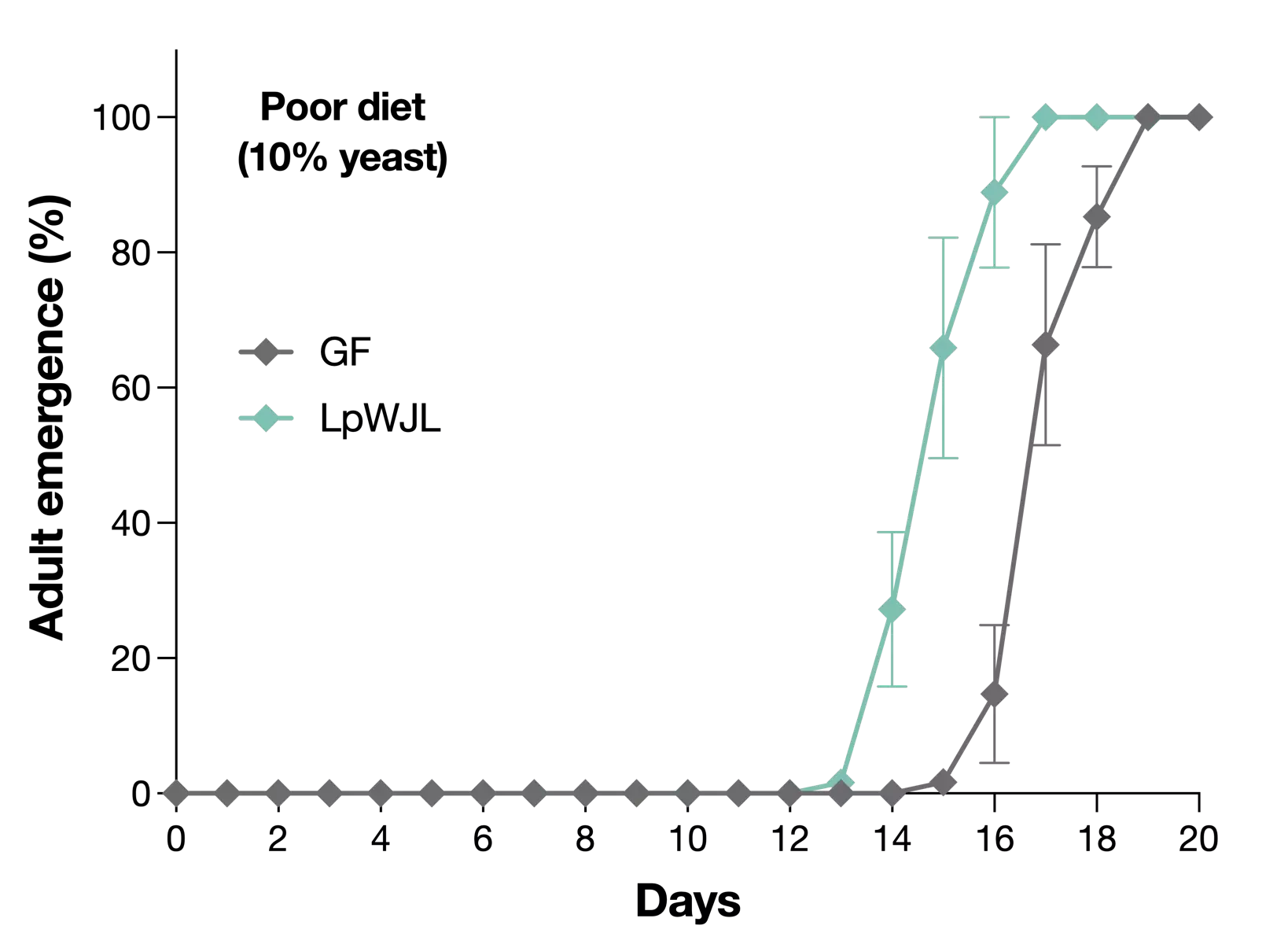
Storelli et al. Cell Metabolism 2011
Drosophila (fruit flies) have a simple microbiota, composed of about 20 bacterial species, mainly L. plantarum and E. faecalis. The researchers were interested in the specificities of these two commensal species in association with mono-colonized larvae. The first results show that germ-free insects have a delayed growth and that LpWJL alone restores normal growth.
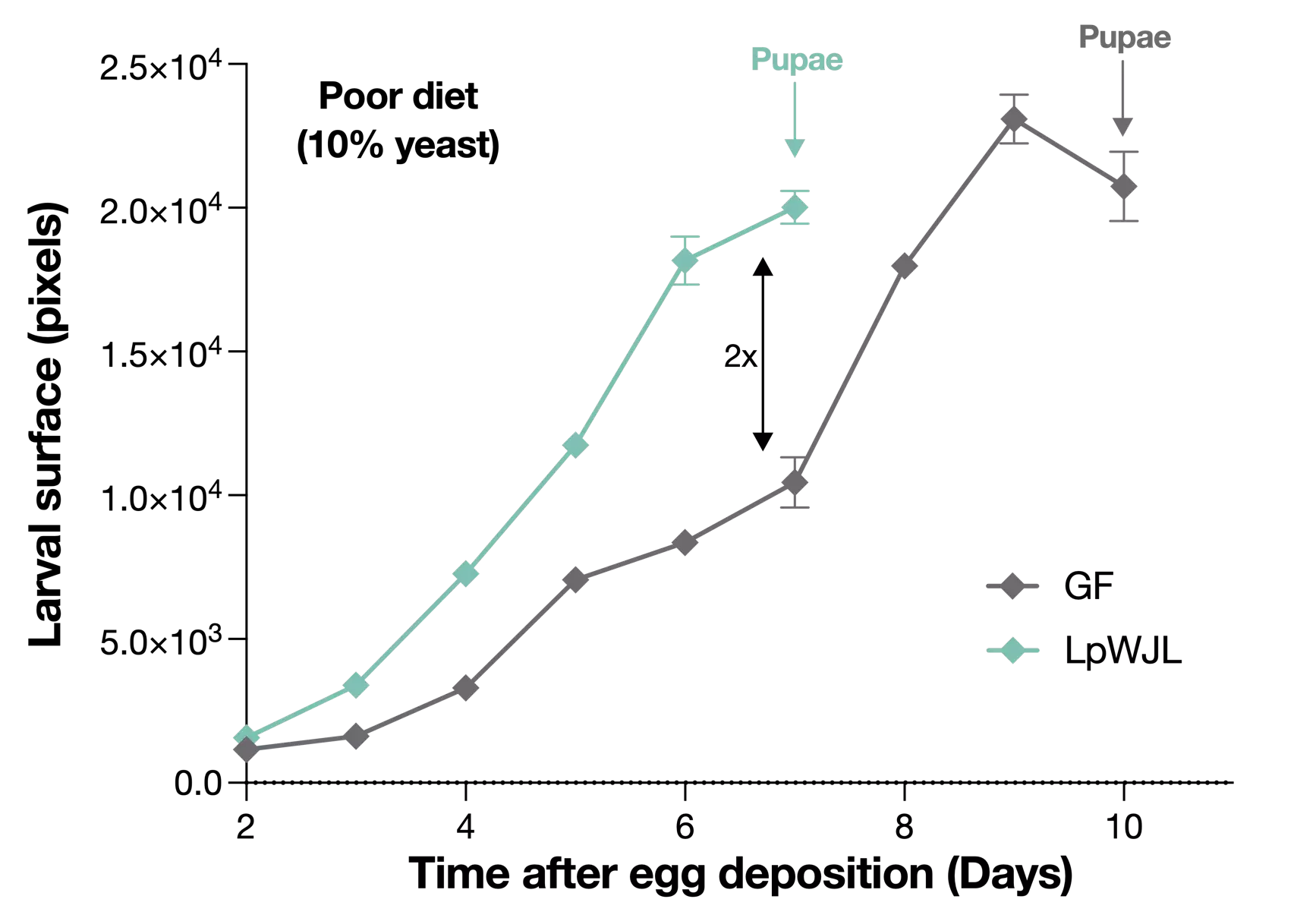
In conditions of undernourishment, the association with LpWJL leads to a better larval growth. The emergence of the adult size is significantly faster and the surface of the larvae is 2 times larger 7 days after the egg deposition in the probiotic group with LpWJL than in the axenic group (GF “Germ Free”).
2. Pre-clinical study: in Mammals
The efficacy of LpWJL on growth was evaluated in a study conducted on mice monocolonized with LpWJL fed with either a conventional diet or a low-calorie diet, with a positive control group (individuals with a conventional microbiota) and a negative control group (axenic individuals, GF “Germ Free”).
The efficacy of LpWJL strain alone restores the effect of the microbiota on mammalian growth (weight and height) in both diet conditions.
Whatever the diet administered, the mice supplemented with LpWJL show growth comparable to conventional mice, and superior to axenic mice (+52% in weight and 14% in height).


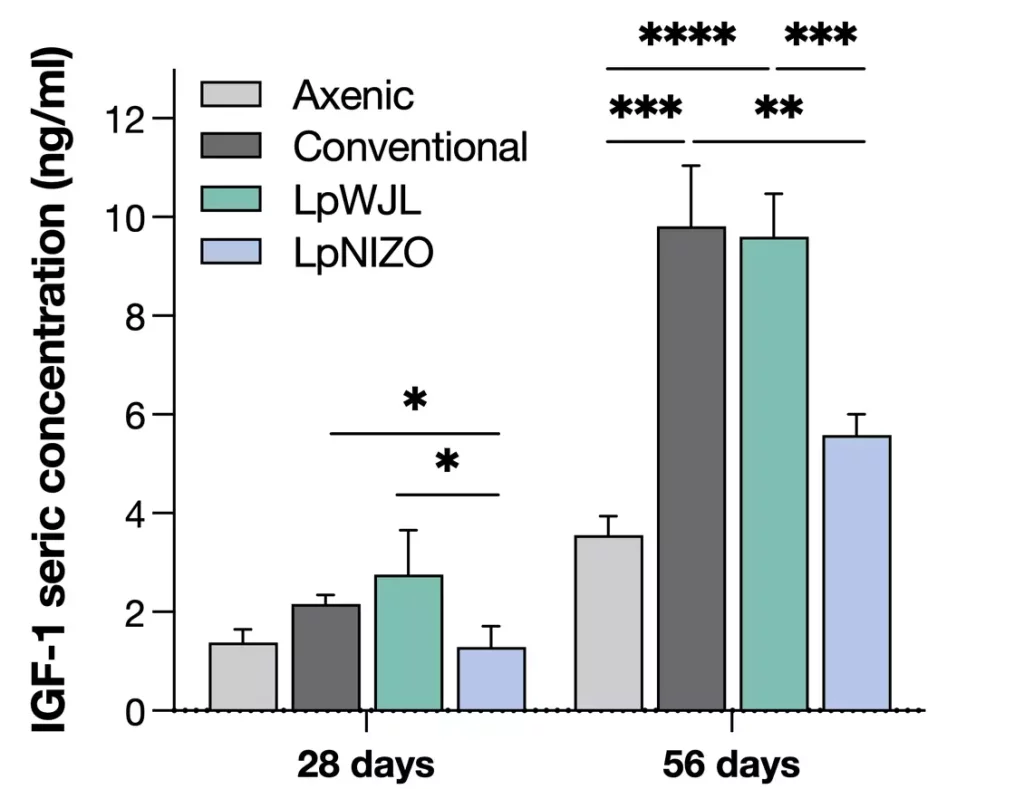
The LpWJL group presents higher serum IGF-1 growth hormone concentration than the negative control group – a level similar to that of the positive control group.
The potential of L. plantarum WJL to face major health issues
The potential of the LpWJL strain, through its specific mechanism of action, is very wide: pediatric nutrition, healthy ageing, sports nutrition, and even animal feed.

Children under the growth curves - Small eaters
Growth is a key period in life. Ensuring the right nutritional intake of children from an early age is to ensure harmonious growth and development. The causes of growth slowdown are many and varied. Among them, a side effect of the main treatment of ADHD in children (methylphenidate) is appetite suppression, and a consequence is a stalling of growth rates.
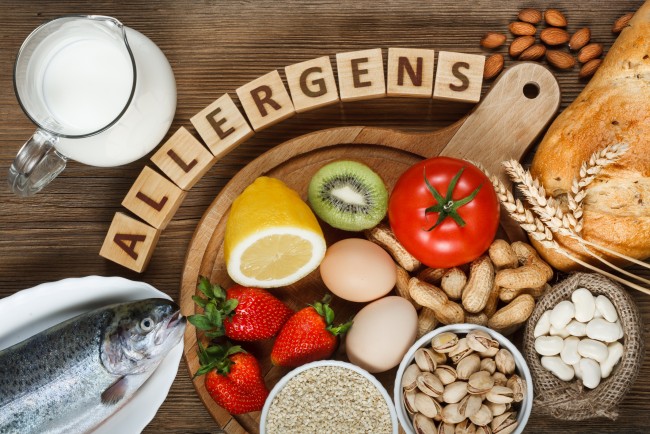
Food intolerances - allergies
According to the WHO, allergies are now the fourth most common chronic disease in the world, and, in 2050, 1 in 2 people could be concerned. In USA, approximately 8% of children have food allergies and 40% of them are allergic to several foods (Pediatrics, 2018).

Vegetarians - exclusive dieters
LpWJL helps vegetarians to optimize the protein intake of the food bowl. These diets are followed by more and more people around the world. In Europe: on average, between 5 and 10% are vegetarians (OpinionWay, 2016), 12% in the Middle East (Europe Israel, 2020), 13% in the United States (Public Policy, 2013) and up to 30% in India ( Census India, 2014).

Mild eating disorders
Globally an estimated 16 million had clinical anorexia and bulimia nervosa in 2017 (IHME, 2019). Anorexia nervosa is most often triggered between the ages of 14 and 17, with a peak prevalence at age 16.
By optimizing the absorption of amino acids, LpWJL is of interest in supporting treatments, promoting a physiological action on weight gain.

Cachexia - Renutrition
LpWJL is a solution to support the renutrition of patients following a significant weight loss. This can occur because of a disability or a disease such as cancer or Alzheimer, which prevents people from eating. The consequences of undernutrition and weight loss are a higher risk of infection or fall as well as an alteration of the different physiological or psychological functions.

Sarcopenia - Healthy ageing
Between 2015 and 2050, the proportion of people aged 60 and over in the world population will increase by 34% (WHO). In 2016, WHO qualified sarcopenia as a "disease". Sarcopenia currently affects about 1/5 Europeans over 55, and plans to go up to 30 million by 2045. (Inserm).

Sport nutrition
By increasing the amino acids absorption in a natural and physiological way, LpWJL represents a big potential for sport nutrition market. The global sports nutrition market size was valued at USD 40.0 billion in 2021 and is expected to expand at a compound annual growth rate of 8.5% from 2022 to 2030 (Share Report, 2020). 69% of US consumers of sports nutrition or performance beverages agree that they contain too many artificial ingredients (Mintel, 2020).

Denutrition - Humanitarian
Globally, 149 million children under 5 were stunted (too short for age), and 45 million were wasted (too thin for height) in 2020 (WHO). According to the WHO, “the developmental, economic, social, and medical impacts of the global burden of malnutrition are serious and lasting, for individuals and their families, for communities and for countries”.

Animal Feed
The strain's potential does not stop with humans: LpWJL could benefit animal feed, to optimize the growth and development of farm animals.
